If you're crazy about crescents, you'll find your happy place this week between the Moon and Venus. Meanwhile, we shift our focus from 45P/H-M-P to another famous periodic comet, 2P/Encke.
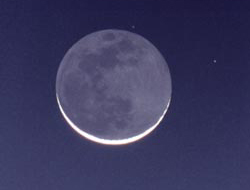
What makes a crescent special? Is it the contrast of pointed horns and bowed arc or simply the Moon's fragile appearance that's so breathtaking? If I could find the bumper sticker, I'd happily slap I Brake For Crescents on the back of my car.
Late February crescendos with crescents — two brought to us by the Moon and one via Venus. On Friday morning, February 24th, face southeast about 40 minutes before sunrise to spy a sliver Moon not two days from new with its back to the Sun. Low altitude may color the crescent peach, adding to the beauty of the sight.
Three nights later on February 27th, watch for an even thinner Moon to materialize low in the western sky less than a day and a half past new, horns pointed up and ready to charge into the night like a Pamplona bull.
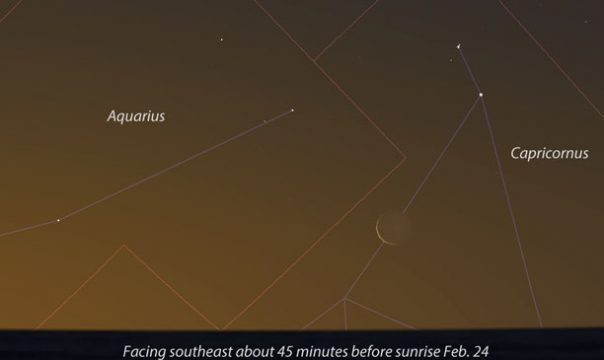
Stellarium
In late February, the ecliptic arcs sharply up and away from the western horizon, which gives the Moon a swift kick into the evening sky and makes sighting the young crescent easy work.
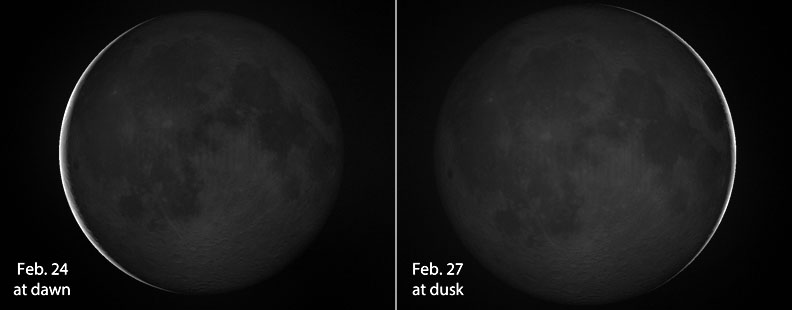
Virtual Moon Atlas / C. Legrand & P. Chevalley
Since phases of the Moon and the Earth — as seen from the Moon — are complementary, a sickle Moon implies a nearly full Earth for an astronaut staring back in our direction. Earth, being nearly four times as large as the Moon appears in our sky, reflects a great deal of sunlight back at the Moon, lighting up the remainder of the lunar disk in an ember-like luminescence called earthshine. Earthshine is most obvious when the Moon mimics that Mona Lisa smile.
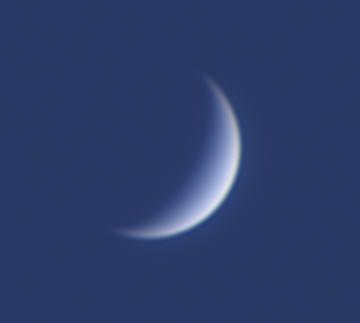
Venus throws its scimitar in the ring, too! Since greatest eastern elongation in mid-January, Venus has been slimming down while also growing in apparent size as it approaches inferior conjunction on March 25th. Currently a banana-thick crescent measuring 43″ from tip to toe, the planet is large enough to show a shape in any telescope, even 10× binoculars.
The crescent will become larger and strikingly thinner in the coming weeks, so be sure to keep an eye on it. Just like the Moon, the Venusian crescent will flip from one side of the planet to the opposite when it reappears west of the Sun in the morning sky in late March.
Now that I've dragged you by the horns this far, you'll be happy to know there's more than one reasonably bright evening comet vying for your attention. We've been tracking 45P/Honda-Mrkos-Pajdusakova for the past couple weeks, and while it's still just visible in binoculars and now sports a short tail, periodic comet 2P/Encke has been slowly brightening at the same time. Pity it's only now reaching magnitude +9 and soon will be departing the evening sky.
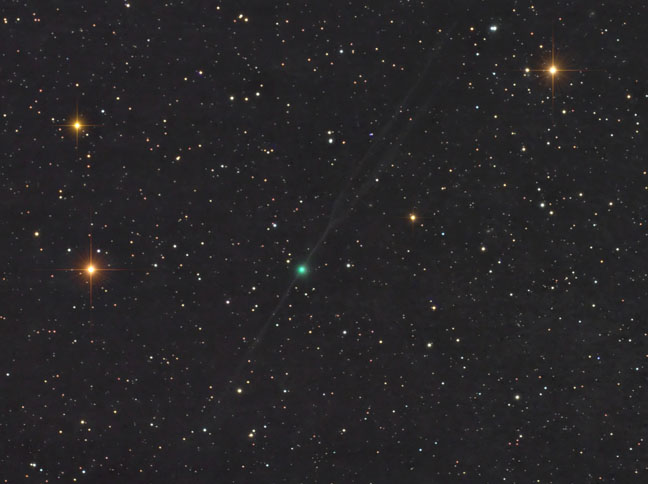
Damian Peach
As I write this, the comet is cozying up to Venus in Pisces, a compact fuzzy glow of magnitude +8.8. It's brightening as it runs westward toward the Sun and will reach perihelion on March 10th. Comet 2P/Encke could become as bright as magnitude +6.5 in the next 10 days and become visible in binoculars shortly before disappearing in the solar glow around March 6th. The best time to catch it is near the end of evening twilight. On February 27th, the thin lunar crescent and Venus will neatly frame the comet. Photos anyone?
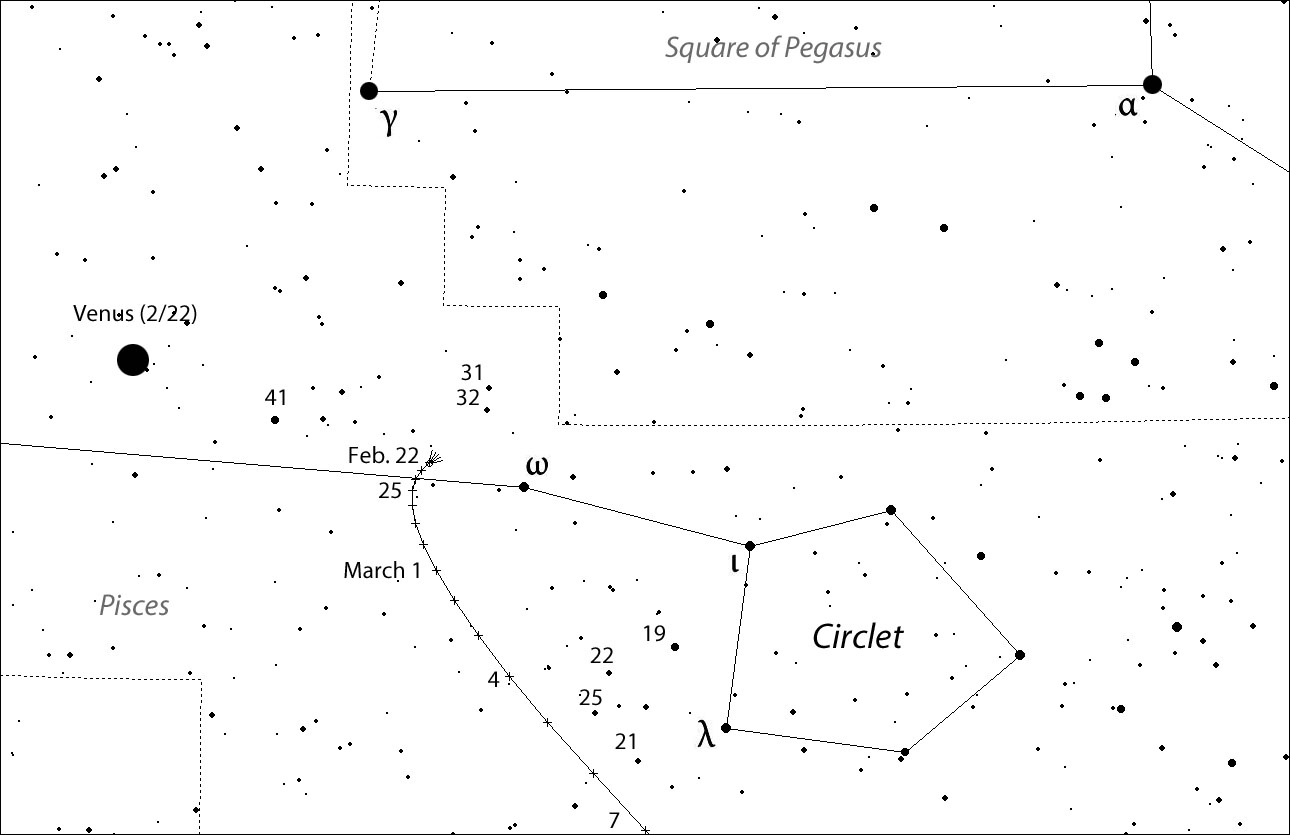
Created with Chris Marriott's SkyMap
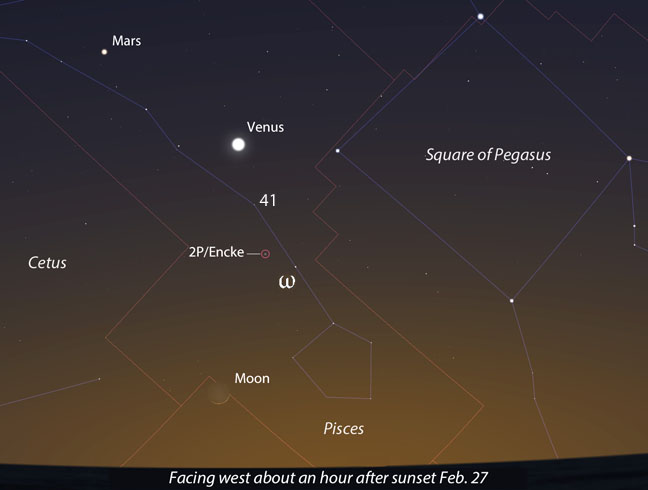
Map: Bob King, Source: Stellarium
For northern hemisphere observers, that's all she wrote, but southern skywatchers will have another go at 2P/Encke when it returns to the morning sky in late March at magnitude +8 and fading.
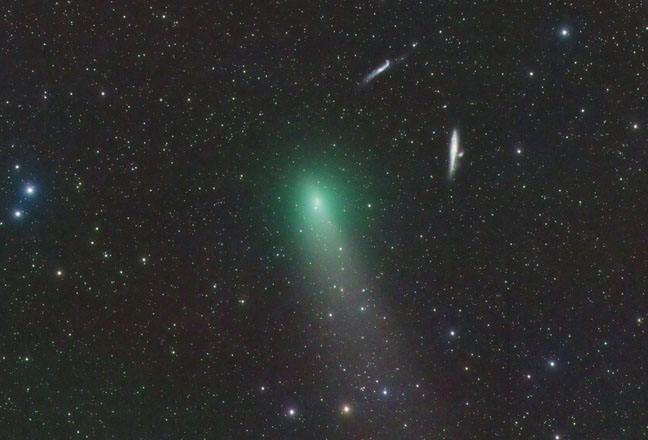
José J. Chambó
And of course don't forget 45P/Honda-Mrkos-Pajdusakova. Now that it's become well placed in a moonless sky, amateur astronomers have been having better luck recording new details, including a fresh, new tail. The photo above, taken by José J. Chambó, perfectly captures the comet's ethereal beauty in the context of deep space.
 13
13








Comments
February 23, 2017 at 4:14 pm
The evening crescent of Mercury 9th of april will be my spring target (-;
You must be logged in to post a comment.
Bob KingPost Author
February 23, 2017 at 11:19 pm
Jakob,
Yes, we have another crescent on the way! Too bad Venus will have departed the evening sky by then.
You must be logged in to post a comment.
April 4, 2017 at 2:39 pm
Pointed my scope at Mercury last night, not cresent like but nice 33% sunlit surface on a crisp and cool evening here in Scandinavia.
You must be logged in to post a comment.
Bob KingPost Author
April 4, 2017 at 8:28 pm
Thank you Jakob for sharing your Mercury views with our readers.
You must be logged in to post a comment.
April 9, 2017 at 3:18 pm
Less than an hour ago I saw the 14% crescent of our innermost planet. I caught Mercury 20 minutes after sunset through my 7 inch Maksutov. The seeing wasn´t the very best but good enough to see " the fat banana" (-:
You must be logged in to post a comment.
Graham-Wolf
February 23, 2017 at 6:06 pm
Hi Bob
Another awesome comet (and lunar) column from yourself.
A great prelude/warm-up to 2p/Encke watching.
Sadly, too far North for another month for us "southerners" way down here, at 46 South, NZ.
Meanwhile, 45p/H-M-P continues to be my main comet of choice at the moment, down here, down-under.
Latest results from me, plus one that Chris Wyatt (Walcha, NSW) posted just an hour ago to the yahoogroups/CometObs website. It's now Mv 8, and much easier to see this morning against a moonless pre-dawn sky. Same HP (Hipparchus Catalogue) stars as used this week, and previously reported.
I've also been using a 20x80 Polarex Spotterscope f4 refractor with 2 deg FOV. Great to find today, that Chris has also seen C/2016 V2 (Johnson), but at 7.5 deg alt near his Queensland border ~ 25 South, it is still too far north for me. Chris's skies at Walcha are typically ZLM 6.2 -6.4, slightly better than me at the Fairfield Backyard Observatory (FBO) at -45.8976000 S, +170.4017000 E, 27.8m amsl. I've also been informally using my 10x50s. Taking a line from Saturn through Jupiter down to the N.E. Horizon. Nice to see blazing Arcturus (Alpha Bootis) nearby, to guide me in!
45p
Feb 22.563 UT Mv 7.6 18 arcmin coma DC1 20x80 R 20x (120' FOV) WOLF
Feb 22.573 UT Mv 7.8 20.8 arcmin coma DC1 12cm f4 L 50x (96" FOV) WOLF
Feb 23.583 UT Mv 7.8 24 arcmin coma DC1 20x80R 20x (120' FOV) WOLF
Feb 23.594 UT Mv 8.0 26.3 arcmin DC1 " " WOLF
Feb 23.64 UT Mv 8.0 22.1 arcmin DC1 " " WYATT
Keep up the great work, Bob, and good luck to all your readers, out there!!
Regards from 46 South, NZ.
Graham W. Wolf
You must be logged in to post a comment.
SNH
February 24, 2017 at 5:27 pm
Have seen Encke only so far in my 8x56s. It is brightening, but we'll see if I can catch it in my 7x35s. Good article.
Scott
You must be logged in to post a comment.
Bob KingPost Author
February 24, 2017 at 9:56 pm
Thanks Scott. Glad it's within range. We still have a little time left ...
You must be logged in to post a comment.
AB
February 25, 2017 at 1:25 am
What is the explanation for the "tuning fork" tail on Encke?
You must be logged in to post a comment.
Bob KingPost Author
February 25, 2017 at 9:28 am
AB.
One is the ion tail, the other is the dust trail (seen both ahead and behind the comet) in the comet's orbital plane.
You must be logged in to post a comment.
atticaowl
February 28, 2017 at 5:59 pm
Greetings Bob:
On the way to work on February 24th morning, I spotted the thin moon both naked eye and 10x25mm binoculars. Little did I know at the time, I had completed the first part of observing three crescents and a sinking comet!!
Sunday brought clear skies and excellent seeing conditions for a great view of both Venus and 2P/Encke in my
6" Orion XT6 reflector. It was my first sighting of this comet since the 1980's, and Venus never fails to dazzle.
Monday the 27th held the last Moon at sunset. Not only did I spot this, I recorded 4 features from the Rukl's Lunar atlas I had yet to see! Theses were Kastner, plus its satellite features G and A. Plus LaProuse E at 114x. What series of views, all from a telescope saved from the trash (for free last fall.) Comet 45P/Honda-Mrkos-Pajdusakova was seen again too!
Thanks for bringing these sights to our attention, proof small telescope observing remains fresh and exciting.
You must be logged in to post a comment.
Bob KingPost Author
February 28, 2017 at 6:15 pm
Thank you, atticaowl. Really enjoyed your crescent and comet adventure, and knowing that you did it using a "rescue scope" made it that much sweeter!
You must be logged in to post a comment.
atticaowl
March 4, 2017 at 9:16 am
Hi Bob: Thanks for the "rescue scope" quote I never thought of that! And as I caught the telescope in the back on a truck headed to the dump, I also "rescued" its "mate" at work as well a few weeks later. While tossing out press room junk during a slow period, I noticed another department had tossed two matching wooden stools 21" inches tall in the dumpster. While each was broken, it was plain to see all that was needed was to take them apart and build a complete sound stool. Made to order, from trash to treasure, an observing chair with a story.
You must be logged in to post a comment.
You must be logged in to post a comment.